 W
WIn the industrial design field of human-computer interaction, a user interface (UI) is the space where interactions between humans and machines occur. The goal of this interaction is to allow effective operation and control of the machine from the human end, whilst the machine simultaneously feeds back information that aids the operators' decision-making process. Examples of this broad concept of user interfaces include the interactive aspects of computer operating systems, hand tools, heavy machinery operator controls, and process controls. The design considerations applicable when creating user interfaces are related to, or involve such disciplines as, ergonomics and psychology.
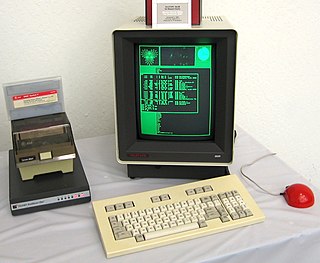 W
WIn computing, the Blit was a programmable bitmap graphics terminal designed by Rob Pike and Bart Locanthi Jr. of Bell Labs in 1982.
 W
WA browser user interface is a method of interacting with an application, typically hosted on a remote device, via controls presented within a web browser. This is an alternative to providing controls via a separate application with a dedicated graphical user interface (GUI) or command-line interface (CLI).
 W
WA command-line interface (CLI) processes commands to a computer program in the form of lines of text. The program which handles the interface is called a command-line interpreter or command-line processor. Operating systems implement a command-line interface in a shell for interactive access to operating system functions or services. Such access was primarily provided to users by computer terminals starting in the mid-1960s, and continued to be used throughout the 1970s and 1980s on VAX/VMS, Unix systems and personal computer systems including DOS, CP/M and Apple DOS.
 W
WA computer terminal is an electronic or electromechanical hardware device that can be used for entering data into, and transcribing data from, a computer or a computing system. The teletype was an example of an early day hardcopy terminal, and predated the use of a computer screen by decades.
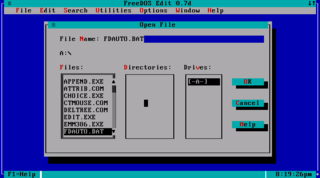 W
WA console application is a program designed to be used via a text-only computer interface, such as a text terminal, the command line interface of some operating systems or the text-based interface included with most Graphical User Interface (GUI) operating systems, such as the Win32 console in Microsoft Windows, the Terminal in macOS, and xterm in Unix. A user typically interacts with a console application using only a keyboard and display screen, as opposed to GUI applications, which normally require the use of a mouse or other pointing device. Many console applications such as command line interpreters are command line tools, but numerous text-based user interface (TUI) programs also exist.
 W
WDasher is an input method and computer accessibility tool which enables users to compose text without using a keyboard, by entering text on a screen with a pointing device such as a mouse, touch screen, or mice operated by the foot or head. Such instruments could serve as prosthetic devices for disabled people who cannot use standard keyboards, or where the use of one is impractical.
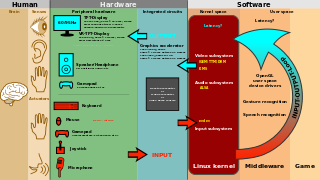 W
WUser interface design (UI) or user interface engineering is the design of user interfaces for machines and software, such as computers, home appliances, mobile devices, and other electronic devices, with the focus on maximizing usability and the user experience. The goal of user interface design is to make the user's interaction as simple and efficient as possible, in terms of accomplishing user goals.
 W
WIn computing, the desktop metaphor is an interface metaphor which is a set of unifying concepts used by graphical user interfaces to help users interact more easily with the computer. The desktop metaphor treats the computer monitor as if it is the top of the user's desk, upon which objects such as documents and folders of documents can be placed. A document can be opened into a window, which represents a paper copy of the document placed on the desktop. Small applications called desk accessories are also available, such as a desk calculator or notepad, etc.
 W
WA dialogue system, or conversational agent (CA), is a computer system intended to converse with a human. Dialogue systems employed one or more of text, speech, graphics, haptics, gestures, and other modes for communication on both the input and output channel.
 W
WA display device is an output device for presentation of information in visual or tactile form. When the input information that is supplied has an electrical signal the display is called an electronic display.
 W
WThe KiddiComp concept, envisioned by Alan Kay in 1968 while a PhD candidate, and later developed and described as the Dynabook in his 1972 proposal "A personal computer for children of all ages", outlines the requirements for a conceptual portable educational device that would offer similar functionality to that now supplied via a laptop computer or a tablet or slate computer with the exception of the requirement for any Dynabook device offering near eternal battery life. Adults could also use a Dynabook, but the target audience was children.
 W
WFlight envelope protection is a human machine interface extension of an aircraft's control system that prevents the pilot of an aircraft from making control commands that would force the aircraft to exceed its structural and aerodynamic operating limits. It is used in some form in all modern commercial fly-by-wire aircraft. The professed advantage of flight envelope protection systems is that they restrict a pilot's excessive control inputs, whether in surprise reaction to emergencies or otherwise, from translating into excessive flight control surface movements. Notionally, this allows pilots to react quickly to an emergency while blunting the effect of an excessive control input resulting from "startle," by electronically limiting excessive control surface movements that could over-stress the airframe and endanger the safety of the aircraft.
 W
WA focus-plus-context screen is a specialized type of display device that consists of one or more high-resolution "focus" displays embedded into a larger low-resolution "context" display. Image content is displayed across all display regions, such that the scaling of the image is preserved, while its resolution varies across the display regions.
 W
WA framebuffer is a portion of random-access memory (RAM) containing a bitmap that drives a video display. It is a memory buffer containing data representing all the pixels in a complete video frame. Modern video cards contain framebuffer circuitry in their cores. This circuitry converts an in-memory bitmap into a video signal that can be displayed on a computer monitor.
 W
WGNOME Shell is the graphical shell of the GNOME desktop environment starting with version 3, which was released on April 6, 2011. It provides basic functions like launching applications, switching between windows and is also a widget engine. GNOME Shell replaced GNOME Panel and some ancillary components of GNOME 2.
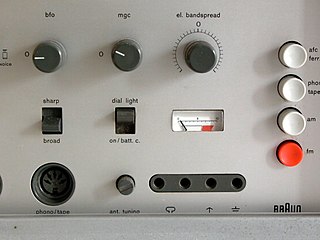 W
WHardware interface design (HID) is a cross-disciplinary design field that shapes the physical connection between people and technology in order to create new hardware interfaces that transform purely digital processes into analog methods of interaction. It employs a combination of filmmaking tools, software prototyping, and electronics breadboarding.
 W
WThe Humane Interface: New Directions for Designing Interactive Systems (ISBN 0-201-37937-6) is a book about user interface design written by Jef Raskin and published in 2000. It covers ergonomics, quantification, evaluation, and navigation.
 W
WIntegrated Computer Solutions, Inc. (ICS) of Waltham, MA, provides consulting, support, training and add-on products for the Qt cross-platform framework. ICS is a Qt Software Preferred Training and Consulting Partner. ICS’s clients are typically large-scale organizations whose core businesses are technology dependent.
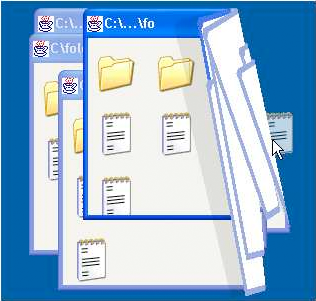 W
WAn interaction technique, user interface technique or input technique is a combination of hardware and software elements that provides a way for computer users to accomplish a single task. For example, one can go back to the previously visited page on a Web browser by either clicking a button, pressing a key, performing a mouse gesture or uttering a speech command. It is a widely used term in human-computer interaction. In particular, the term "new interaction technique" is frequently used to introduce a novel user interface design idea.
 W
WKampyle is a software and website feedback analytics company founded in 2007 and based in Ramat Gan, Israel. Kampyle's feedback service is used to improve a company's ability to understand their website users and customer analytics. Kampyle was acquired by Medallia in October 2016.
 W
WKinect is a line of motion sensing input devices produced by Microsoft and first released in 2010. The technology includes a set of hardware originally developed by PrimeSense, incorporating RGB cameras, infrared projectors and detectors that mapped depth through either structured light or time of flight calculations, and a microphone array, along with software and artificial intelligence from Microsoft to allow the device to perform real-time gesture recognition, speech recognition and body skeletal detection for up to four people, among other capabilities. This enables Kinect to be used as a hands-free natural user interface device to interact with a computer system. Kinect is a peripheral that sits atop the user's display similar to a webcam.
 W
WThe language icon is a specific icon designed for people to select a specific language to use when they face multi-lingual, multi-national websites.
 W
WLight-on-dark color scheme, also called black mode, dark mode, dark theme or night mode, is a color scheme that uses light-colored text, icons, and graphical user interface elements on a dark background and is often discussed in terms of computer user interface design and web design.
 W
WIn computer security, logging in is the process by which an individual gains access to a computer system by identifying and authenticating themselves. The user credentials are typically some form of "username" and a matching "password", and these credentials themselves are sometimes referred to as a login. In practice, modern secure systems often require a second factor such as email or SMS confirmation for extra security.
 W
WA ludic interface is a type of computer interface. In the field of human–computer interaction (HCI), the term ludic Interfaces describes a discipline that focuses on user interfaces that are inherently "playful". This field of interface research and design draws on concepts introduced by Dutch historian and cultural theorist Johan Huizinga in the book Homo Ludens . Huizinga's work is considered an important contribution to the development of game studies.
 W
WAaron Marcus is an American user-interface and information-visualization designer, as well as a computer graphics artist.
 W
WA mnemonic is an underlined alphanumeric character, typically appearing in a menu title, menu item, or the text of a button or component of the user interface. A mnemonic indicates to the user which key to press to activate a command or navigate to a component.
 W
WA monochrome monitor is a type of CRT computer monitor which was very common in the early days of computing, from the 1960s through the 1980s, before color monitors became popular. They are still widely used in applications such as computerized cash register systems, owing to the age of many registers. Green screen was the common name for a monochrome monitor using a green "P1" phosphor screen; the term is often misused to refer to any block mode display terminal, regardless of color, e.g., IBM 3279, 3290.
 W
WMonome is an Upstate New York-based company, founded by Brian Crabtree and Kelli Cain, that produces sound modules and MIDI controllers. Monome is also the name of their initial product, a grid-based controller that is now sometimes simply referred to as grid.
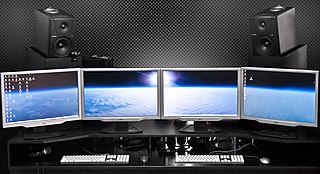 W
WMulti-monitor, also called multi-display and multi-head, is the use of multiple physical display devices, such as monitors, televisions, and projectors, in order to increase the area available for computer programs running on a single computer system. Research studies show that, depending on the type of work, multi-head may increase the productivity by 50–70%.
 W
WThe Nielsen Norman Group (NN/g) is an American computer user interface and user experience consulting firm, founded in 1998 by Jakob Nielsen and Don Norman. Their work includes an analysis of the interface of Microsoft's Windows 8 operating system. They have done analyses of the user experience of mobile devices and intranets. As of 2000, Bruce Tognazzini joined Nielsen Norman Group as a partner.
 W
WIn human–computer interaction, an organic user interface (OUI) is defined as a user interface with a non-flat display. After Engelbart and Sutherland's graphical user interface (GUI), which was based on the cathode ray tube (CRT), and Kay and Weiser's ubiquitous computing, which is based on the flat panel liquid-crystal display (LCD), OUI represents one possible third wave of display interaction paradigms, pertaining to multi-shaped and flexible displays. In an OUI, the display surface is always the locus of interaction, and may actively or passively change shape upon analog inputs. These inputs are provided through direct physical gestures, rather than through indirect point-and-click control. Note that the term "Organic" in OUI was derived from organic architecture, referring to the adoption of natural form to design a better fit with human ecology. The term also alludes to the use of organic electronics for this purpose.
 W
WIn human–computer interaction, paper prototyping is a widely used method in the user-centered design process, a process that helps developers to create software that meets the user's expectations and needs—in this case, especially for designing and testing user interfaces. It is throwaway prototyping and involves creating rough, even hand-sketched, drawings of an interface to use as prototypes, or models, of a design. While paper prototyping seems simple, this method of usability testing can provide useful feedback to aid the design of easier to use products. This is supported by many usability professionals.
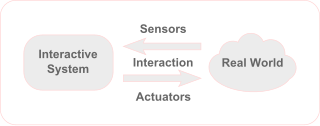 W
WPhysical computing involves interactive systems that can sense and respond to the world around them. While this definition is broad enough to encompass systems such as smart automotive traffic control systems or factory automation processes, it is not commonly used to describe them. In a broader sense, physical computing is a creative framework for understanding human beings' relationship to the digital world. In practical use, the term most often describes handmade art, design or DIY hobby projects that use sensors and microcontrollers to translate analog input to a software system, and/or control electro-mechanical devices such as motors, servos, lighting or other hardware.
 W
WPlesk is a commercial web hosting and server data center automation software with a control panel developed for Linux and Windows-based retail hosting service providers. Plesk's user management model is suitable for dedicated and shared hosting, allowing server administrators to set up new websites, reseller accounts, email accounts, and edit and create DNS entries through a web-based interface.
 W
WPresentation–abstraction–control (PAC) is a software architectural pattern. It is an interaction-oriented software architecture, and is somewhat similar to model–view–controller (MVC) in that it separates an interactive system into three types of components responsible for specific aspects of the application's functionality. The abstraction component retrieves and processes the data, the presentation component formats the visual and audio presentation of data, and the control component handles things such as the flow of control and communication between the other two components.
 W
WPreview is a computing function to display a document, page, or film before it is produced in its final form. In the case of printed material this is known as "print preview".
 W
WProGuard is an open source command-line tool that shrinks, optimizes and obfuscates Java code. It is able to optimize bytecode as well as detect and remove unused instructions. ProGuard is free software and is distributed under the GNU General Public License, version 2.
 W
WThe Reactable is an electronic musical instrument with a tabletop tangible user interface that was developed within the Music Technology Group at the Universitat Pompeu Fabra in Barcelona, Spain by Sergi Jordà, Marcos Alonso, Martin Kaltenbrunner and Günter Geiger.
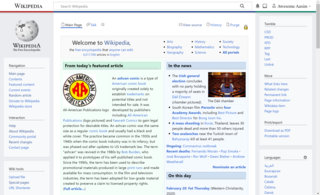 W
WResponsive web design (RWD) is an approach to web design that makes web pages render well on a variety of devices and window or screen sizes. Recent work also considers the viewer proximity as part of the viewing context as an extension for RWD. Content, design and performance are necessary across all devices to ensure usability and satisfaction.
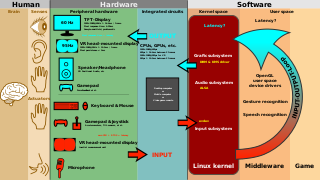 W
WResponsiveness as a concept of computer science refers to the specific ability of a system or functional unit to complete assigned tasks within a given time. For example, it would refer to the ability of an artificial intelligence system to understand and carry out its tasks in a timely fashion. It is one of the criteria under the principle of robustness. The other three are observability, recoverability, and task conformance.
 W
WIn computing, scratch input is an acoustic-based method of Human-Computer Interaction (HCI) that takes advantage of the characteristic sound produced when a finger nail or other object is dragged over a surface, such as a table or wall. The technique is not limited to fingers; a stick or writing implements can also be used. The sound is often inaudible to the naked ear. However, specialized microphones can digitize the sounds for interactive purposes. Scratch input was invented by Mann et al. in 2007, though the term was first used by Chris Harrison et al.
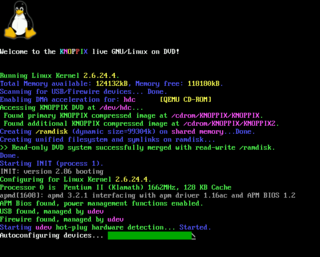 W
WThe system console, computer console, root console, operator's console, or simply console is the text entry and display device for system administration messages, particularly those from the BIOS or boot loader, the kernel, from the init system and from the system logger. It is a physical device consisting of a keyboard and a screen, and traditionally is a text terminal, but may also be a graphical terminal. System consoles are generalized to computer terminals, which are abstracted respectively by virtual consoles and terminal emulators. Today communication with system consoles is generally done abstractly, via the standard streams, but there may be system-specific interfaces, for example those used by the system kernel.
 W
WA tangible user interface (TUI) is a user interface in which a person interacts with digital information through the physical environment. The initial name was Graspable User Interface, which is no longer used. The purpose of TUI development is to empower collaboration, learning, and design by giving physical forms to digital information, thus taking advantage of the human ability to grasp and manipulate physical objects and materials.
 W
WA terminal emulator, terminal application, or term, is a computer program that emulates a video terminal within some other display architecture. Though typically synonymous with a shell or text terminal, the term terminal covers all remote terminals, including graphical interfaces. A terminal emulator inside a graphical user interface is often called a terminal window.
 W
WIn computing, text-based user interfaces (TUI), is a retronym describing a type of user interface (UI) common as an early form of human–computer interaction, before the advent of graphical user interfaces (GUIs). Like GUIs, they may use the entire screen area and accept mouse and other inputs. They may also use color and often structure the display using special graphical characters such as ┌ and ╣, referred to in Unicode as the "box drawing" set. The modern context of use is usually a terminal emulator.
 W
WThis Place are a digital retail agency, designing sustainable digital businesses that work for customers, for shareholders and for society. Driven by purpose as much as profit, they design websites, apps and digital services used by millions of people. Working with clients across the globe from a London hub, they are part agency, part consultancy and true partner
 W
Wttyrec is a program or its file format capable of recording the TTY output of a text-mode program together with timestamps and then replaying it.
 W
WA video wall is a special multi-monitor setup that consists of multiple computer monitors, video projectors, or television sets tiled together contiguously or overlapped in order to form one large screen. Typical display technologies include LCD panels, Direct View LED arrays, blended projection screens, Laser Phosphor Displays, and rear projection cubes. Jumbotron technology was also previously used. Diamond Vision was historically similar to Jumbotron in that they both used cathode-ray tube (CRT) technology, but with slight differences between the two. Early Diamond vision displays used separate flood gun CRTs, one per subpixel. Later Diamond vision displays and all Jumbotrons used field-replaceable modules containing several flood gun CRTs each, one per subpixel, that had common connections shared across all CRTs in a module; the module was connected through a single weather-sealed connector.
 W
WViewMAX is a CUA-compliant file manager supplied with DR DOS versions 5.0 and 6.0. It is based on a cut-down runtime version of Digital Research's GEM/3 graphical user interface modified to run only a single statically built application, the ViewMAX desktop. Support for some unneeded functions has been removed whilst some new functions were added at the same time. Nevertheless, the systems remained close enough for ViewMAX to recognize GEM desktop accessories automatically and to allow some native GEM applications to be run inside the ViewMAX environment. Many display drivers for GEM 3.xx could be used by ViewMAX as well, enabling ViewMAX to be used with non-standard display adapters and higher resolutions than possible using the default set of ViewMAX drivers. Also, Digital Research's SID86, the symbolic instruction debugger that shipped with DR DOS 3.xx and provided dedicated functions to debug GEM applications, could be used for ViewMAX as well.
 W
WA virtual console (VC) – also known as a virtual terminal (VT) – is a conceptual combination of the keyboard and display for a computer user interface. It is a feature of some Unix-like operating systems such as BSD, Linux, illumos and UnixWare in which the system console of the computer can be used to switch between multiple virtual consoles to access unrelated user interfaces. Virtual consoles date back at least to Xenix and Concurrent CP/M in the 1980s.
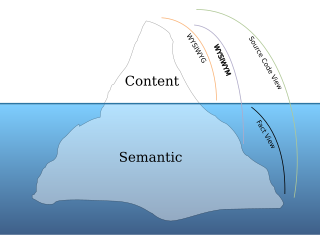 W
WIn computing, What You See Is What You Mean is a paradigm for editing a structured document. It is an adjunct to the better-known WYSIWYG paradigm, which displays the end result of a formatted document as it will appear on screen or in print — without showing the descriptive code underneath.